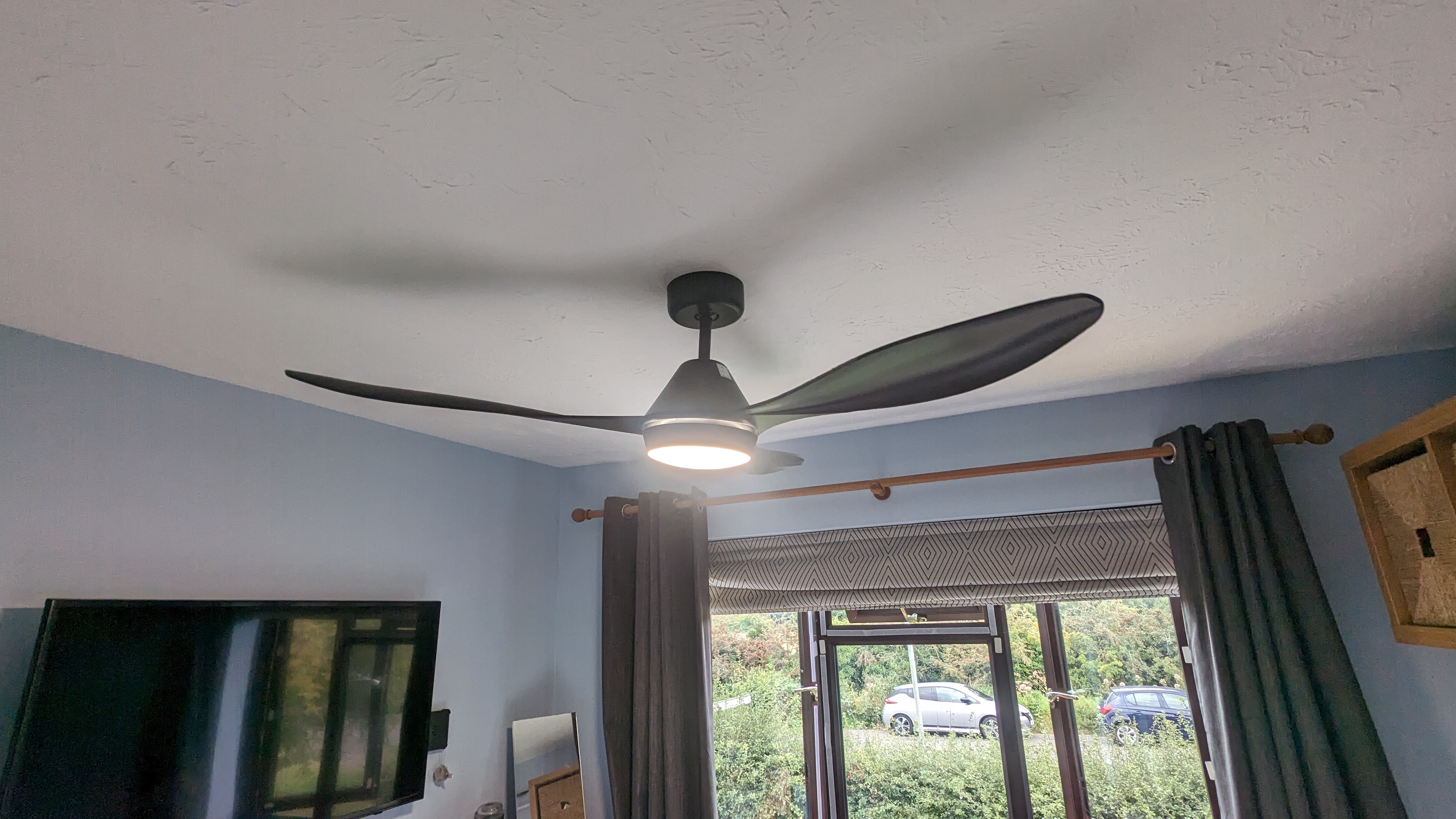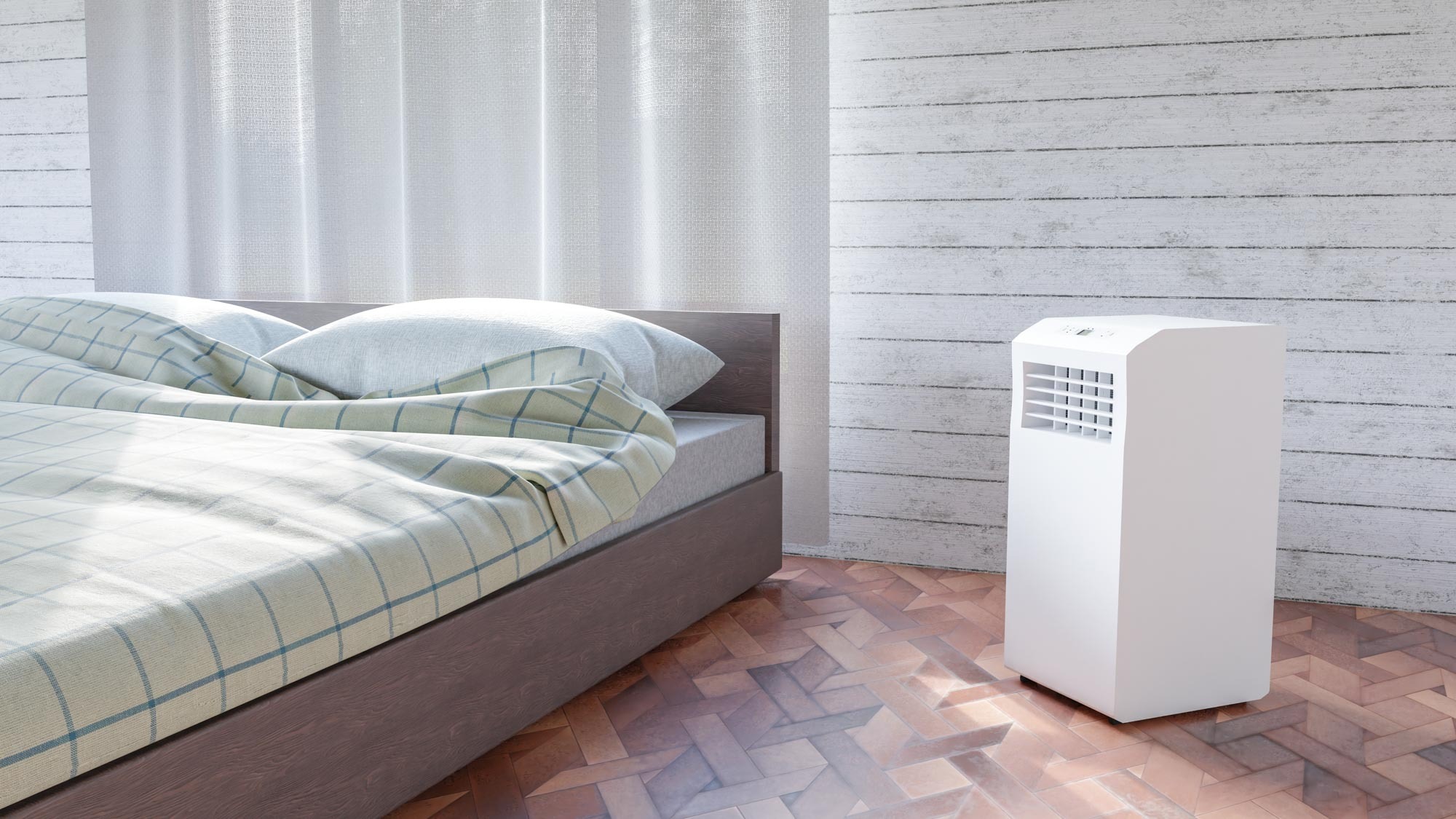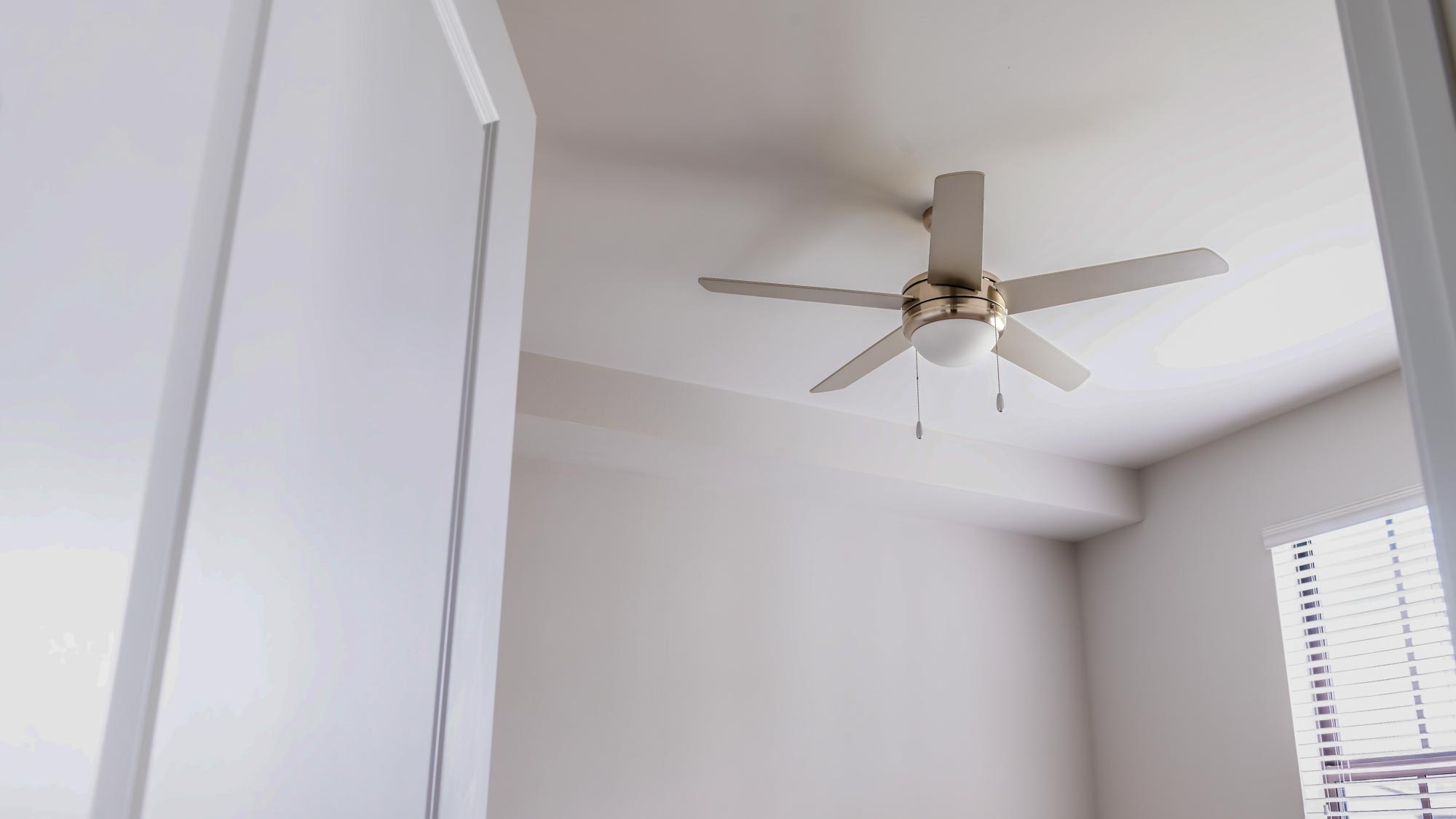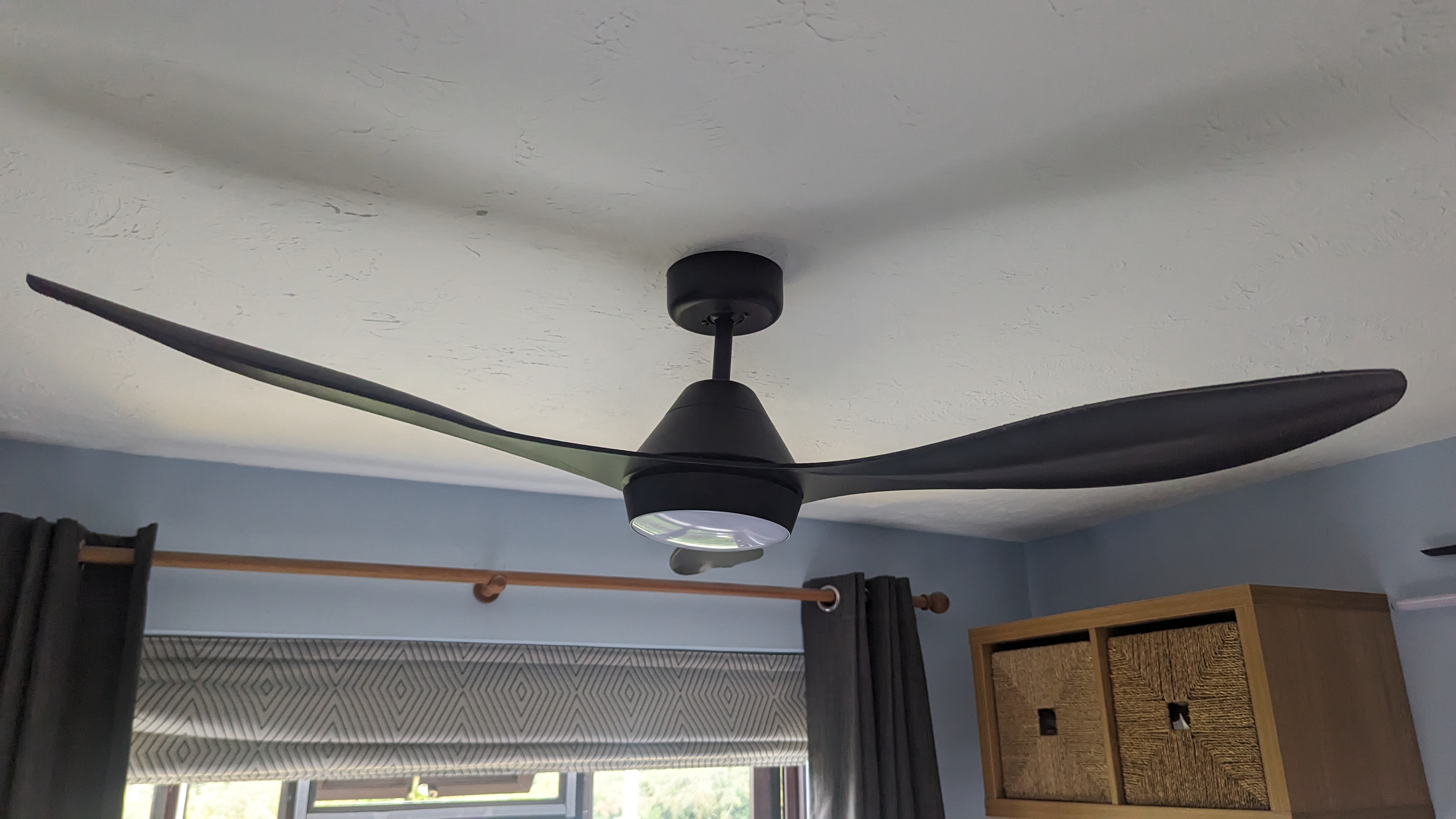I ditched my air conditioner and installed a ceiling fan — and I’m not going back
Air conditioning has its benefits, but I'm now a true believer of the ceiling fan

I am absolutely not a fan of summer, even ones that are as relatively mild as I tend to experience in the UK. Heat, humidity and architecture that was designed to keep inside are not a great combination when you want to keep cool. Thankfully I’ve discovered a very effective (and low cost) way to stay comfortable — a ceiling fan.
I’ve only had the fan for a few months, but it’s already proven to be far more convenient than some of the other ways I’ve tried to keep cool over the summer months — especially air conditioning. The best air conditioners can be invaluable, there’s absolutely no denying that, but it comes with some obvious drawbacks — especially from a cost perspective.
The problem with air conditioning

Not only can air conditioning be rather loud, especially if you have a cheaper unit, it uses a lot of power. Considering energy prices have risen quite a lot the past few years, it's not the most cost-effective way of staying cool. For reference, my current air conditioner uses up to 2.6 kW of power during use, while my ceiling fan is just 45W — or 57 times less.
At my current electricity rate, I’d have to pay £0.73 to run the air conditioner at maximum power for one hour. One hour of cooling is great, but once that hour is up and the power goes off, the temperature in the room is only going to rise. Insulation, window seals, thermal window blinds and any other measures you might be able to take will only delay the inevitable.
I do have solar panels on my home, which could be useful to offset the cost of AC during the day. The problem is that I can generally handle heat during the day, but I can not abide being too hot when I’m trying to go to sleep. I’ve had trouble getting to sleep for a long time, but being too hot is one of the things that makes the problem a thousand times worse.
If that wasn’t bad enough, I have a south facing bedroom window, so in the summer months it starts heating up as soon as the sun rises — which is currently just after 6 a.m. I can tell you now, waking up in a room that feels like an oven is not pleasant. If I weren’t a morning shower person already, then I’d certainly have to make that transition during the summer months.
I could run the AC all night, or set up an elaborate system of smart plugs hoping that it a) works, and b) the noise doesn’t interrupt my sleep. But the simple fact is that while effective, the air conditioner is expensive to run. And living in a country with pretty mild weather, I’d rather save that extra express for the times I really need them.
Like when the temperature rises above 100 degrees, and I have to resort to using aluminum foil to try and keep the fiery weather from getting through my windows.
It’s also worth noting that options for air conditioning are severely limited in the UK. A lack of vertical-sliding windows means you can’t use a window unit, and few residential homes are built with air conditioning in mind. Your choices are go portable, and deal with the heat vent screwing up your efficiency, or spend thousands of pounds on a professional installation.
Ceiling fans can do a surprising amount

Travelling to Orlando made me realize just how capable ceiling fans could be as an alternative. Florida weather is pretty horrible, and when you’re in a line of people that’s exposed to the outdoors, there’s little sense using an air conditioner. It would just be a waste of energy, and a futile endeavor.
But ceiling fans? I experienced first hand that ceiling fans could do a lot of good — even when the local temperature is approaching 90 degrees and you’re surrounded by hot, sweaty tourists.
I’ll admit, I’d always been curious about a ceiling fan, since there isn’t a lot of spare floorspace for a tower fan in a convenient place, but seeing them in action in Florida strengthened my resolve to get around to installing one myself. It certainly couldn’t hurt.
The fan I ended up buying was just over £300, which wasn’t the cheapest option but it wasn’t anywhere close to being the most expensive. It’s also about £50 cheaper than my air conditioner and uses a heck of a lot less power during use. Fifty seven times less, in fact, which means running the fan at maximum power for 8 hours costs just £0.10.
The difference in energy usage is so vast that running the fan that way for an entire week adds £0.71 to my energy bill. Which is still less than running the AC for one hour. The fan itself also cost around £50 less than my air conditioning unit, and the fact I installed it myself saved the hassle of finding an overpriced electrician to do all the work for me.
The fan itself is a game changer

That wasn’t the smartest idea, seeing as how the fan I bought didn’t have traditional wiring and hooking it up to my light switch was a pretty confusing process. Online guidance was unhelpful, to say the least, and I had to spend a bunch of time crouching on a beam in the attic like Gollum to get everything running safely. But I did get it running safely, and it didn’t cost me any more money.
Just a bit of time, energy and a copious amount of curse words. Though anyone who knows me will confirm it doesn’t take much to sully my speech like that.
The benefits were immediately obvious. A ceiling fan has the kind of reach a regular tower fan can only dream of. Larger industrial-looking fans might, but not without causing an absolute ruckus in the process. I’m talking about noise and blowing things that aren’t nailed to the floor across the room. Not only is the ceiling fan quiet, it’s gentle enough that I don’t have to worry about my hair blowing into my eyes all the time.
I don’t even need to use the highest speed settings most of the time either. Speed 3 is usually more than enough to keep me comfortable, so 4 and 5 rarely get called into action.
The added benefit is I can keep the windows open to generate an extra breeze. The AC unit couldn’t manage that, because otherwise all its work would be undone in a matter of minutes. I do keep finding moths and mosquitos in my bedroom, but they’re not that difficult to deal with.
It’s a perfectly acceptable trade-off to being able to enjoy that breeze when I’m trying to go to sleep. I just wish I could stop the blasted thing from clicking when it’s running at high speeds. I tightened the bolts, better secured the bracket to the ceiling and made sure the fan itself isn’t wobbling — but it still happens. I’m just glad I don’t need to use the higher settings very often.
This works for me, but it might not work for you
One thing I have to admit is that I do live in a temperate climate, and the U.K. doesn’t tend to experience the same extremes you might get in other parts of the world. The fact I only have a ceiling fan in the one room is testament to that. So I couldn’t possibly say whether someone in Texas or Southern California would be able to swap out their air conditioner for ceiling fans so easily.
But there’s also a chance that employing a ceiling fan could still be beneficial. Maybe it won’t replace your air conditioner, but it might help circulate the cooler air more effectively, and reduce the unit’s workload in the process. All I know is that, after having finally installed one, I wouldn’t go without a ceiling fan ever again — so they’re well worth checking out.
More from Tom's Guide
Sign up to get the BEST of Tom's Guide direct to your inbox.
Get instant access to breaking news, the hottest reviews, great deals and helpful tips.

Tom is the Tom's Guide's UK Phones Editor, tackling the latest smartphone news and vocally expressing his opinions about upcoming features or changes. It's long way from his days as editor of Gizmodo UK, when pretty much everything was on the table. He’s usually found trying to squeeze another giant Lego set onto the shelf, draining very large cups of coffee, or complaining about how terrible his Smart TV is.
-
bobpaul Regarding the clicking, you need to balance your ceiling fan. Look up ceiling fan weights. It's the exact same concept as balancing the wheels on your car when you replace the tires.Reply -
surferjohn In Southern California on the coast, no need for AC, just good ceiling fans. In the desert areas, we use AC in combination with ceiling fans. They're great for circulating both cool and warm air, so AC and heating costs can actually be lowered quite a bit.Reply
PSA: Recently, the administration put ceiling fans on the hit list. Probably best to buy now if you are in the market. -
USAFRet Reply
PSA: No, they're not on a hit list.surferjohn said:In Southern California on the coast, no need for AC, just good ceiling fans. In the desert areas, we use AC in combination with ceiling fans. They're great for circulating both cool and warm air, so AC and heating costs can actually be lowered quite a bit.
PSA: Recently, the administration put ceiling fans on the hit list. Probably best to buy now if you are in the market.
They are just supposed to be more energy efficient, by 2028. They're not going away. -
bobpaul Reply
Make sure you flip the reversing switch during the cold months when heating is running. When it's running backwards you won't feel the air movement on your skin. The air movement on your skin is what causes the fans to have an apparent cooling effect.surferjohn said:They're great for circulating both cool and warm air, so AC and heating costs can actually be lowered quite a bit.
As an electrical engineer I begrudgingly welcome this rule change. It's really frustrating that we need government regulations like this to push energy efficiency standards, but that's the world we live in. Businesses really don't push these limits on their own unless a product is battery powered, and that's the most frustrating aspect. We have the technology. It's cheap. But they'd rather save $5/unit :-/surferjohn said:Probably best to buy now if you are in the market.
Buy now if you need ceiling fans (that's worth it due to the energy savings regardless). In a few years, if you still need ceiling fans (because you moved, etc) the fans you buy will be even cheaper to operate. Just like the newer microwaves, window A/C, and mini-split systems, these new ceiling fans will most likely be "inverter" style, using a quieter high efficiency 3-phase DC motor. These aren't expensive systems; the motors were already developed many many years ago and have had steady efficiency gains driven by use in brushless power drills, eBikes, diesel freight trains, electric lawn mowers, etc. If you can find an inverter drive ceiling fan you like, buy that now; there's a few on the market, but not many. -
Allen Millington Not viable in Chicagoland. Even with running window fans overnight to reduce house temperature, daytime gets miserable. The area is too humid. That's before considering any operating electronics like PC + Monitor that add even more heat.Reply
